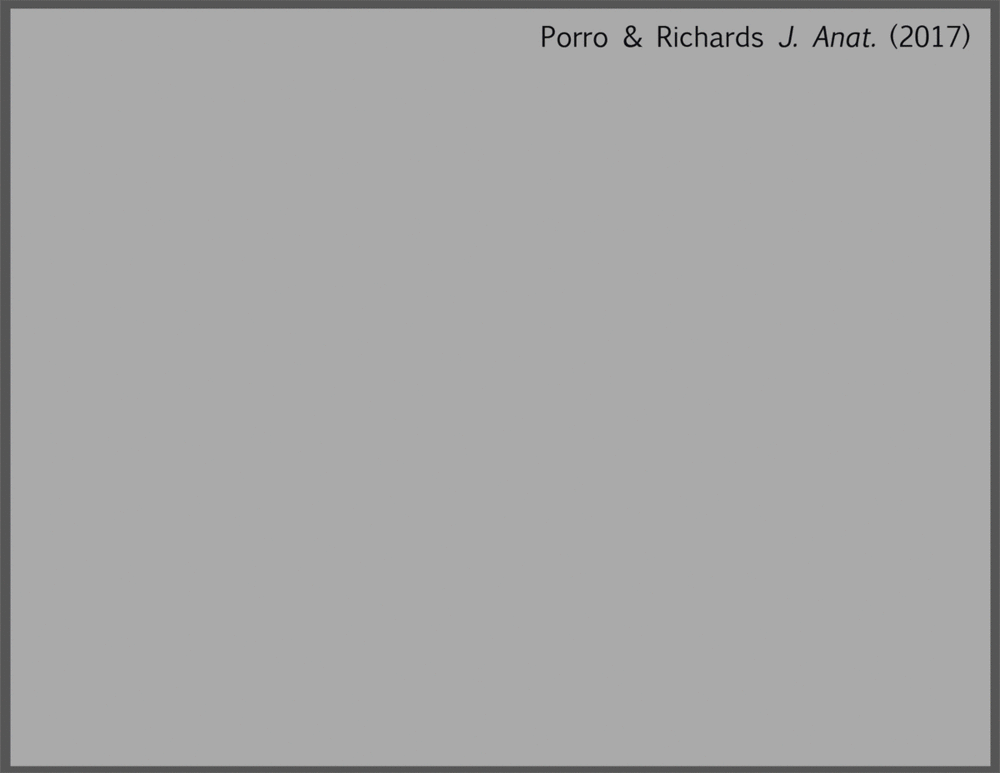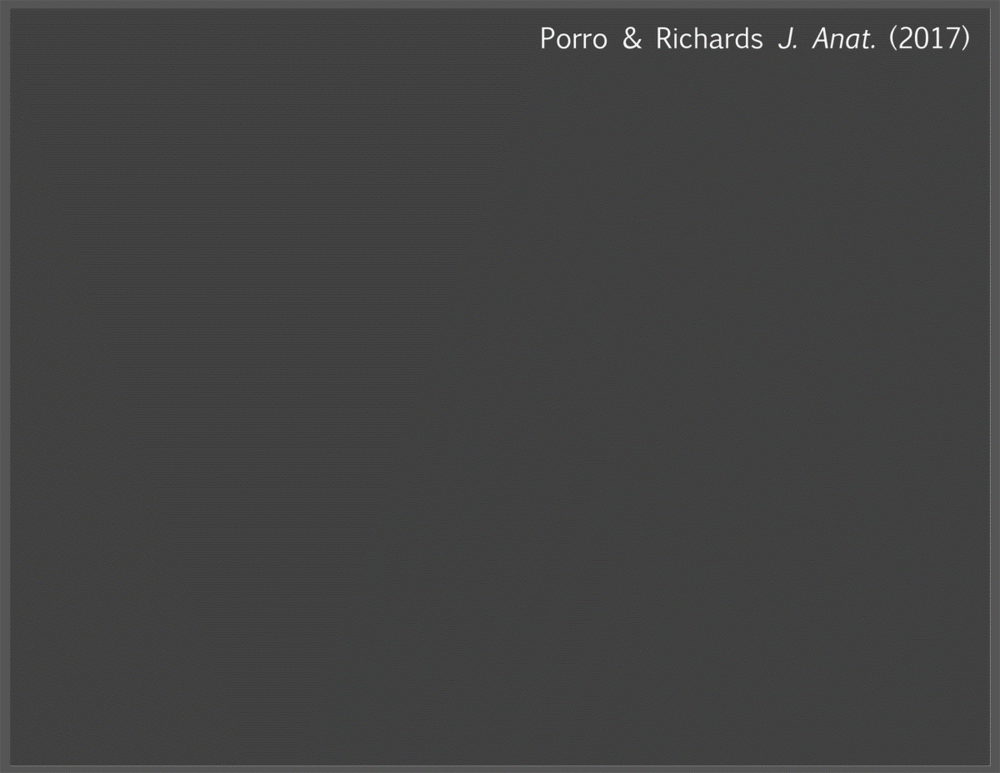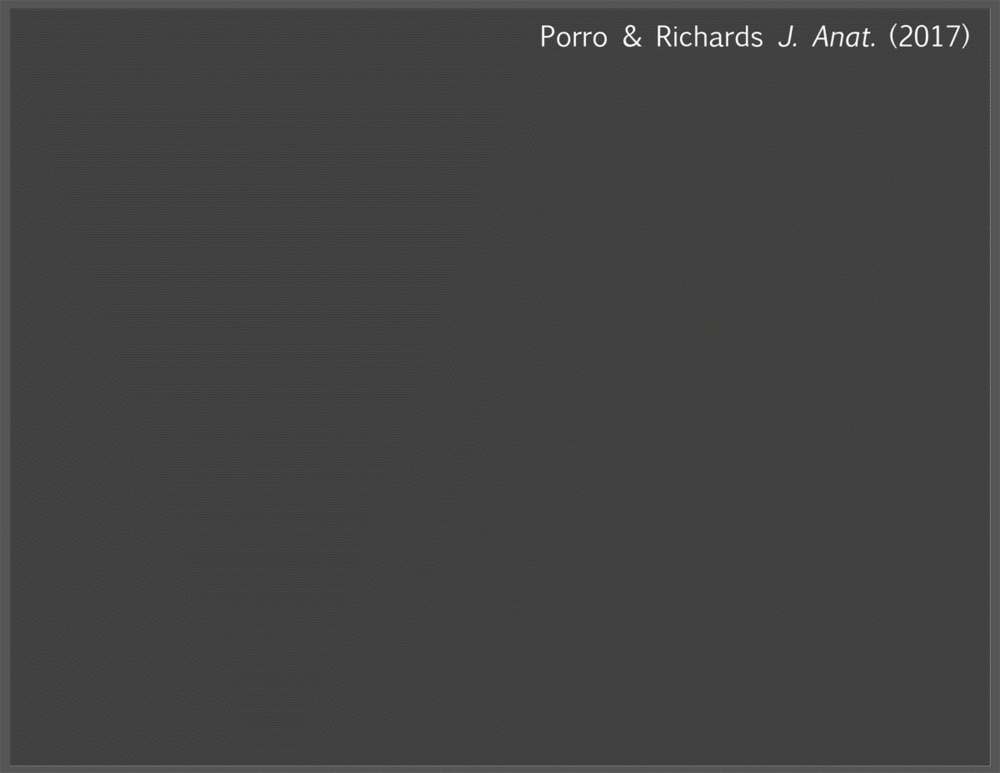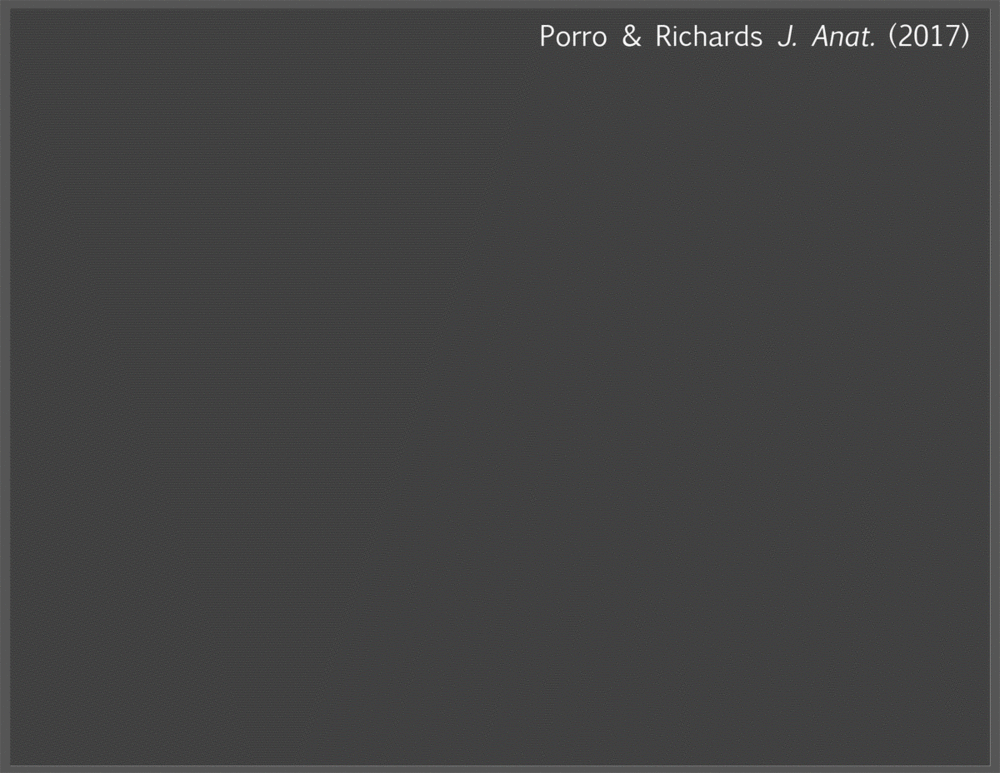Digital dissection of X. laevis
Digital dissection of the model organism Xenopus laevis using contrast‐enhanced computed tomography
Laura B. Porro and Christopher T. Richards
Journal of Anatomy, 26 May 2017, https://doi.org/10.1111/joa.12625.
Click here to view article at the Journal of Anatomy.
Click here to view/download pdf from the Journal of Anatomy.
Click here to view article at Pubmed Central.
Abstract
The African clawed frog, Xenopus laevis, is one of the most widely used model organisms in biological research. However, the most recent anatomical description of X. laevis was produced nearly a century ago. Compared with other anurans, pipid frogs – including X. laevis – exhibit numerous unusual morphological features; thus, anatomical descriptions of more ‘typical’ frogs do not detail many aspects of X. laevis skeletal and soft‐tissue morphology. The relatively new method of using iodine‐based agents to stain soft tissues prior to high‐resolution X‐ray imaging has several advantages over gross dissection, such as enabling dissection of very small and fragile specimens, and preserving the three‐dimensional topology of anatomical structures. Here, we use contrast‐enhanced computed tomography to produce a high‐resolution three‐dimensional digital dissection of a post‐metamorphic X. laevis to successfully visualize: skeletal and muscular anatomy; the nervous, respiratory, digestive, excretory and reproductive systems; and the major sense organs. Our digital dissection updates and supplements previous anatomical descriptions of this key model organism, and we present the three‐dimensional data as interactive portable document format (PDF) files that are easily accessible and freely available for research and educational purposes. The data presented here hold enormous potential for applications beyond descriptive purposes, particularly for biological researchers using this taxon as a model organism, comparative anatomy and biomechanical modelling.
[click image to view enlargement]
Skeletal System
Click here or right-click hyperlink and "save link as" to download interactive pdf.
(requires Adobe Acrobat)
Coronal/transverse micro‐computed tomography (μCT) sections of Xenopus laevis specimen before (A,C,E) and after staining with I2 KI (B,D,F). Position of sections through the head (A,B), abdomen (C,D) and pelvis/hind limb (E,F) are shown in (G).
Skull osteology of Xenopus laevis (A,C,E,G) and Kassina maculata (B,D,F,H). Crania (upper jaw) in dorsal (A,B) and ventral (C,D) views; skull and lower jaw in lateral view (E,F); lower jaw in dorsal view (G,H). AN, angulosplenial; CM, columnella; D, dentary; MN, mentomeckelian; MX, maxilla; N, nasal; PL, palatine; PMX, premaxilla; PRO/EXO, prootic‐exoccipital; PS, parasphenoid; PT, pterygoid; Q, quadrate; QJ, quadratojugal; SE, sphenethmoid; SP, septomaxilla; SQ, squamosal; V, vomer.
Postcranial osteology of Xenopus laevis (A,C) and Kassina maculata (B,D) shown in dorsal (A,B) and ventral (C,D) views. AS, astragalus; CA, calcaneum; CL, clavicle; CO, coracoid; F, femur; H, humerus; IC, ischium; IL, ilium; MC, metacarpals; ME, mesosternum; MT, metatarsals; OM, omosternum; PH, phalanges; PU, pubis; RU, radioulna; S, sacral vertebrae; SC, scapula; SS, suprascapula; SU, fused sacrourostyle; TF, tibiofibula; U, urostyle; V, vertebrae.
Musculature
Click here or right-click hyperlink and "save link as" to download interactive pdf.
(requires Adobe Acrobat)
Head musculature of Xenopus laevis. Musculature of the right orbit in posterolateral (A) and posteromedial (B) views, and in transverse cross‐section through the base of the eyeball (C). Jaw musculature in anterolateral view (D) and transverse cross‐section through the coronoid process (E), and jaw muscle attachments on the skull upper and lower jaws (F). Hyoid musculature in ventral view (G) and posterior oblique view (H) with the skull transparent. Main muscle masses are identified using uppercase abbreviations; muscle attachment sites, small muscle slips and non‐muscle structures are identified using lowercase abbreviations. A2, M. adductor mandibulae A2 (masseter); a2, attachments of A2; A3′, M. adductor mandibular A2 PVM and A3′ (temporalis); a3′, attachments of A3′; A3″, M. adductor mandibulae A3″ (pterygoideus); a3″, attachments of A3″; CN II, optic nerve; ct, central tendon; CUL, M. cucullaris; DM, M. depressor mandibulae; dm, attachments of DM; GHY, M. geniohyoideus; IMA, M. intermandibularis anterior; IMP, M. intermandibularis posterior; LB, M. levator bulbi; PHY, M. petrohyoideus posterior; OBI, M. obliquus inferior; OBS, M. obliquus superior; RB′/RB″/RB′″, portions of M. retractor bulbi; RCA, M. rectus anterior; RCI, M. rectus inferior; RCP, M. rectus posterior; RCS, M. rectus superior; sd, subhyoideus portion of IMP; SHY, M. sternohyoideus.
Back and abdominal musculature of Xenopus laevis; both sides of M. longissimus dorsi and M. coccygeoiliacus are shown, otherwise only right side structures are depicted. Specimen shown in oblique view (A); dorsal view with ligamentous plate, M. longissimus dorsi and M. latissimus dorsi removed (B); ventral view (C); and transverse cross‐sections (D,E) shown in (A). Muscles are identified using uppercase abbreviations; non‐muscle structures are identified using lowercase abbreviations. CGI, M. coccygeoiliacus; ICI, M. intertransversarius capitis inferior; ICS, M. intertransversarius capitis superior; IL, M. iliolumbaris; ITR, M. intertransversarii; LGD, M. longissimus dorsi; lp, ligamentous plate; LTD, M. latissimus dorsi; OBE, M. obliquus externus; PEC, M. pectoralis pars abdominalis; RAP, M. rectus abdominus profundus; RAS, M. abdominus superficialis; TRA, M. transversus abdominus.
Pectoral and forelimb musculature of Xenopus laevis. Dorsal pectoral musculature shown in right dorsolateral view (A) with M. depressor mandibulae and M. latissimus dorsi transparent, right posterolateral view (B) with right suprascapula transparent, and right dorsolateral view (C) with suprascapula transparent. Ventral pectoral and arm musculature shown in ventral (D) and posterior (E) views. Dorsal view of specimen (F) detailing locations of transverse cross‐sections through pectoral musculature (G,H). Arm and forearm musculature in dorsal (I) and ventral (J) views, and transverse cross‐sections through the arm (K) and forearm (L), with sections shown in (I) and (J). Main muscles are identified using uppercase abbreviations; muscle slips and non‐muscle structures are identified using lowercase abbreviations. CRH, M. coracohumeralis; CUL, M. cucullaris; DEL, M. deltoideus; DM, M. depressor mandibulae; DSC, M. dorsalis scapulae; FAM, M. flexor antebrachii medius; FALP, M. flexor antebrachii lateralis profundus; FALS, M. flexor antebrachii lateralis superficialis; FCR, M. flexor carpi radialis; FCU, M. flexor carpi ulnaris; FDC, M. flexor digitorum communis; ICI, M. intertransversarius capitis inferior; ICS, M. intertransversarius capitis superior; ISC, M. interscapularis; LGD, M. longissimus dorsi; LSI, M. levator scapulae inferior; LSS, M. levator scapulae superior; LTD, M. latissimus dorsi; PEC, M. pectoralis pars abdominalis; PEC′, M. pectoralis pars anterior sternalis; PEC″, M. pectoralis pars posterior sternalis; RBA, M. rhomboideus anterior; SHP, M. scapulo‐humeralis profundus posterior; SRI, M. serratus inferior; SRM, M. serratus medius; SRS, M. serratus superior; SSC, M. subscapularis; STR, M. sternoradialis; tp, tympanic capsule; TRI, M. triceps brachii long head; TRI′, M. triceps brachii outer head; TRI″, M. triceps brachii inner head; u, unidentified pectoral girdle muscle.
Attachment sites for pectoral and forelimb musculature of Xenopus laevis. Skull shown in right posterolateral view (A). Right suprascapula and scapula shown in lateral (B) and medial (C) views. Close‐up of pectoral and forelimb skeleton in right posterolateral view (D) and right ventrolateral view (E). Muscle attachment sites are identified using lowercase abbreviations. crh, attachment of M. coracohumeralis; cul, attachment of M. cucullaris; del, attachment of M. deltoideus; dsc, attachment of M. dorsalis scapulae; ici, attachment of M. intertransversarius capitis inferior; ics, attachment of M. intertransversarius capitis superior; isc, attachment of M. interscapularis; lsi, attachment of M. levator scapulae inferior; lss, attachment of M. levator scapulae superior; ltd, attachment of M. latissimus dorsi; pec, attachment of M. pectoralis pars abdominalis; pec′, attachment of M. pectoralis pars anterior sternalis; pec″, attachment of M. pectoralis pars posterior sternalis; rba, attachment of M. rhomboideus anterior; shp, attachment of M. scapulo‐humeralis profundus posterior; sri, attachment of M. serratus inferior; srm, attachment of M. serratus medius; srs, attachment of M. serratus superior; ssc, attachment of M. subscapularis; str, attachment of M. sternoradialis; tri, attachment of M. triceps brachii long head; tri′, attachment of M. triceps brachii outer head; tri″, attachment of M. triceps brachii inner head.
Pelvic and thigh musculature of Xenopus laevis. Pelvic musculature in right dorsolateral (A) and ventral (B) views with the ligamentous plate removed. Superficial (C,D) and deep (E,F) thigh muscles in dorsal (C,E) and ventral (D,F) views. Dorsal view of specimen (G) showing location of cross‐sections through the pelvis (H) and thigh (I–K). Muscles are identified using uppercase abbreviations; non‐muscle structures are identified using lowercase abbreviations. ADD, M. adductor magnus, dorsal head; ADL, M. adductor longus; ADV, M. adductor magnus, ventral head; CGI, M. coccygeoiliacus; CR, M. cruralis; GLM, M. glutaeus magnus; GMA, M. gracilis major; GMI, M. gracilis minor; GML, M. gemellus; IE, M. iliacus externus, superficial layer; IE′, M. iliacus externus, middle layer; IE″, M. iliacus externus, extra middle layer; IE′″, M. iliacus externus, deep layer; IFB, M. iliofibularis; IFM, M. iliofemoralis; II, M. iliacus internus; IL, M. iliolumbaris; LGD, M. longissimus dorsi; lp, ligamentous plate; OBE, M. obturator externus; OBI, M. obturator internus; PT, M. pectineus; PY, M. pyriformis; SA, M. sartorius; SM, M. semimembranosus; ST, M. semitendinosus; TFL, M. tensor fascia latae.
Attachment sites for pelvic and thigh musculature of Xenopus laevis. Right ilium/pubis/ischium and urostyle in lateral view (A) and right ilium in medial view (B). Right femur in dorsal (C) and ventral (D) views. Muscle attachment sites are identified using lowercase abbreviations. add, attachment of M. adductor magnus, dorsal head; adl, attachment of M. adductor longus; adv, attachment of M. adductor magnus, ventral head; cgi, attachment of M. coccygeoiliacus; cr, attachment of M. cruralis; glm, attachment of M. glutaeus magnus; gma, attachment of M. gracilis major; gmi, attachment of M. gracilis minor; gml, attachment of M. gemellus; ie, attachment of M. iliacus externus, superficial layer; ie′, attachment of M. iliacus externus, middle layer; ie″, attachment of M. iliacus externus, extra middle layer; ie′″, attachment of M. iliacus externus, deep layer; ifb, attachment of M. iliofibularis; ifm, attachment of M. iliofemoralis; ii, attachment of M. iliacus internus; il, attachment of M. iliolumbaris; obe, attachment of M. obturator externus; obi, attachment of M. obturator internus; pt, attachment of M. pectineus; py, attachment of M. pyriformis; sa, attachment of M. sartorius; sm, attachment of M. semimembranosus; st, attachment of M. semitendinosus.
Shank, tarsus and foot musculature of Xenopus laevis. Right shank and tarsal musculature in dorsal (A) and ventral (B) views. Dorsal view of specimen (C) showing location of cross‐sections through the shank (D,E) and tarsus (F). Right foot musculature in dorsal (G) and ventral (H) views. Attachment sites on the right tibiofibula in dorsal (I) and ventral (J) views, and for the right tarsus in dorsal (K) and ventral (L) views. Main muscles are identified using uppercase abbreviations; muscle attachment sites and non‐muscle structures are identified using lowercase abbreviations. ABD 5, M. abductor brevis dorsalis digiti V; abd 5, attachment of M. abductor brevis dorsalis digiti V; ABDH, M. abductor brevis dorsalis hallucis; abdh, attachment of M. abductor brevis dorsalis hallucis; ABP 5, M. abductor brevis plantaris digiti V; abp 5, attachment site of M. abductor brevis plantaris digiti V; ABPH, M. abductor brevis plantaris hallucis; EBM 2, M. extensor brevis medius digiti II; ebm 2, attachment of M. extensor brevis medius digiti II; EBP 2–4, M. extensor brevis profundus digiti II–IV; EBS 1, M. extensor brevis superficialis hallucis; ebs 1, attachment of M. extensor brevis superficialis hallucis; EBS 2–4, M. extensor brevis superficialis digiti II–IV; ebs 2–4, attachment of M. extensor brevis superficialis digiti II–IV; ECD, M. extensor cruris brevis; ecd, attachment of M. extensor cruris brevis; EDCL, M. extensor digitorum communis longus; FDBS, M. flexor digitorum brevis superficialis; IPD, M. interphalageales digitorum III–V; IT, M. intertarsalis; it, attachment of M. intertarsalis; LUM, M. lumbricales; PE, M. peroneus; pe, attachment of M. peroneus; PL, M. plantaris longus; pl, attachment of M. plantaris longus; plt, plantaris tendon; PP, M. plantaris profundus; pp, attachment of M. plantaris profundus; TA, M. tarsalis anticus; ta, attachment of M. tarsalis anticus; TAB, M. tibialis anticus brevis; tab, attachment of M. tibialis anticus brevis; TAL, M. tibialis anticus longus; tal, attachment of M. tibialis anticus longus; TBP, M. tibialis posticus; tbp, attachment of M. tibialis posticus; TP, M. tarsalis posticus; tp, attachment of M. tarsalis posticus; u, unknown foot muscle.
Nervous System
Click here or right-click hyperlink and "save link as" to download interactive pdf.
(requires Adobe Acrobat)
Nervous system of Xenopus laevis. Brain in dorsal (A,C) and left lateral (B,D) views, with brain transparent in (C) and (D) to illustrate internal ventricles and pineal body. Cranial nerves in dorsal view (E), with eyes, nasal capsules, brain and spinal cord transparent. Left and right trigeminal nerves (F) in dorsal view. Peripheral nervous system in dorsal view (G), with brain, spinal cord and skeleton transparent (cranial nerves not shown). caq, cerebral aqueduct; cbl, cerebellum; cbh, cerebral hemispheres; CN I–X, cranial nerves 1–10; dch, diencephalon; ft, filum terminale; gg, Gasserian ganglion; hyp, hypothalamus; ifr, infundibular recess; mmt, maxilla‐mandibular trunk; mob, medulla oblongata; ncp, nasal capsules; opl, optic lobes; pn, pineal body; pnv, palatine nerve; S 1–10, spinal nerves 1–10; sc, spinal cord; v 1 and 2, first and second ventricles; v3, third ventricle; v4, fourth ventricle; vo, optic ventricles.
Digestive, Urogenital, and Respiratory Systems
Click here or right-click hyperlink and "save link as" to download interactive pdf.
(requires Adobe Acrobat)
Digestive, urogenital and respiratory systems of Xenopus laevis. Digestive and urogenital organs in ventral (A) and dorsal (B) views. Respiratory system in ventral view (C). bld, bile and cystic ducts; dil, M. dilator laryngis; eso, esophagus; gal, gallbladder; imxg, intermaxillary glands; kid, kidney; liv, liver; lgin, large intestine and rectum; lng, lung; lyx, larynx; pan, pancreas; smin, small intestine; spl, spleen; sto, stomach; thd, thyroid gland; thm, thymus gland; tst, testes; urt, ureter.
Adapted with permission from the Anatomical Society, Journal of Anatomy: Porro & Richards (2017). Digital dissection of the model organism Xenopus laevis using contrast-enhanced computed tomography. J Anat. August 1, 2017; 231 (2): 169-191. DOI: 10.1111/joa.12625. Copyright 2017.
This work is licensed under a Creative Commons Attribution 4.0 International License. The images or other third party material in this article are included in the article’s Creative Commons license, unless indicated otherwise in the credit line; if the material is not included under the Creative Commons license, users will need to obtain permission from the license holder to reproduce the material. To view a copy of this license, visit http://creativecommons.org/licenses/by/4.0/
Last Updated: 2019-09-01
















